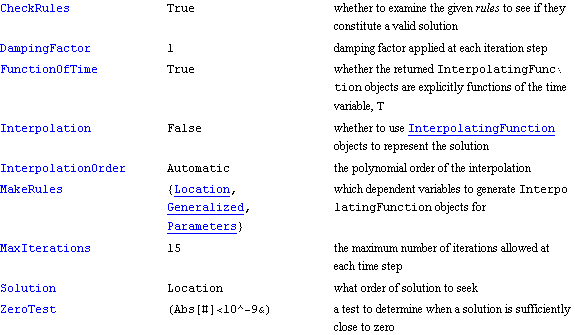SolveMech
2D/3D• SolveMech[t] attempts to find a location solution to the current model at time t. SolveMech returns a list of rules containing the global coordinates of each body.
• SolveMech[{t1, t2, ... , tn}] returns a nested list of solution rules containing solution points at all of the ti.
• SolveMech[{t1, t2, ... , tm}, n], n  m, returns a nested list of solution rules containing solution points at all of the ti, with the remaining n-m solution points interspersed evenly throughout the ti. m, returns a nested list of solution rules containing solution points at all of the ti, with the remaining n-m solution points interspersed evenly throughout the ti.
• SolveMech[rules] takes the supplied list (or nested list) of rules and uses them as initial guesses for the next solution attempt. In this case the value of time t is also taken from rules.
• SolveMech[None] or SolveMech[] attempts to find a single location solution to the current non-time-dependent model. • For models that are not time-dependent, the time specification None can be omitted.
• The following options can be given:

• Solution may be set to Location, Velocity, Acceleration, Static, Kinematic, or Dynamic.
• For example, SolveMech[t, Solution->Velocity] returns the complete set of location and velocity solution rules, etc.
• The CheckRules option can be used to prevent SolveMech from testing supplied initial guesses to see if they are valid, thus, SolveMech[rules, Solution->Acceleration, CheckRules->False] calculates the acceleration solution based on the location and velocity specified in the supplied rules, regardless of their validity.
• The ZeroTest option should specify a function that returns True if applied to a number that is sufficiently close to zero.
• Interpolation->True causes SolveMech to interpolate the solution rules, which is only meaningful if more than one solution point is requested.
• If the Interpolation option is specified, the InterpolatingFunction objects returned incorporate the first- or second-order information contained in the solution, if a velocity or acceleration solution was specified.
• The FunctionOfTime option is used to cause the InterpolatingFunction objects returned to be explicitly functions of the time variable, T.
• See also: BuildMech. Further Examples Load the Modeler2D package and define a simple model. Because the model is dependent on time, T, SolveMech can be called with a single argument giving the value of time.
Out[2]= |  |
If given a list of time values, SolveMech seeks a solution at each value, or at each time value plus additional time values evenly dispersed among those explicitly given.
Out[3]= |  |
Out[4]= |  |
The Solution option controls what order solution is sought, and whether to solve for the Lagrange multipliers.
Out[5]= |  |
Out[6]= |  |
Solution rules can also be output as InterpolatingFunction objects. Note that constant values are recognized and not interpolated.
Out[7]= |  |
Out[8]= |  |
By changing the ZeroTest we can make SolveMech seek a more accurate solution.
Out[9]= |  |
Out[10]= |  |
Or we can iterate toward the solution one step at a time with StepMech.
Out[11]= |  |
Out[12]= |  |
Out[13]= |  |
See HelpModel2D.
|